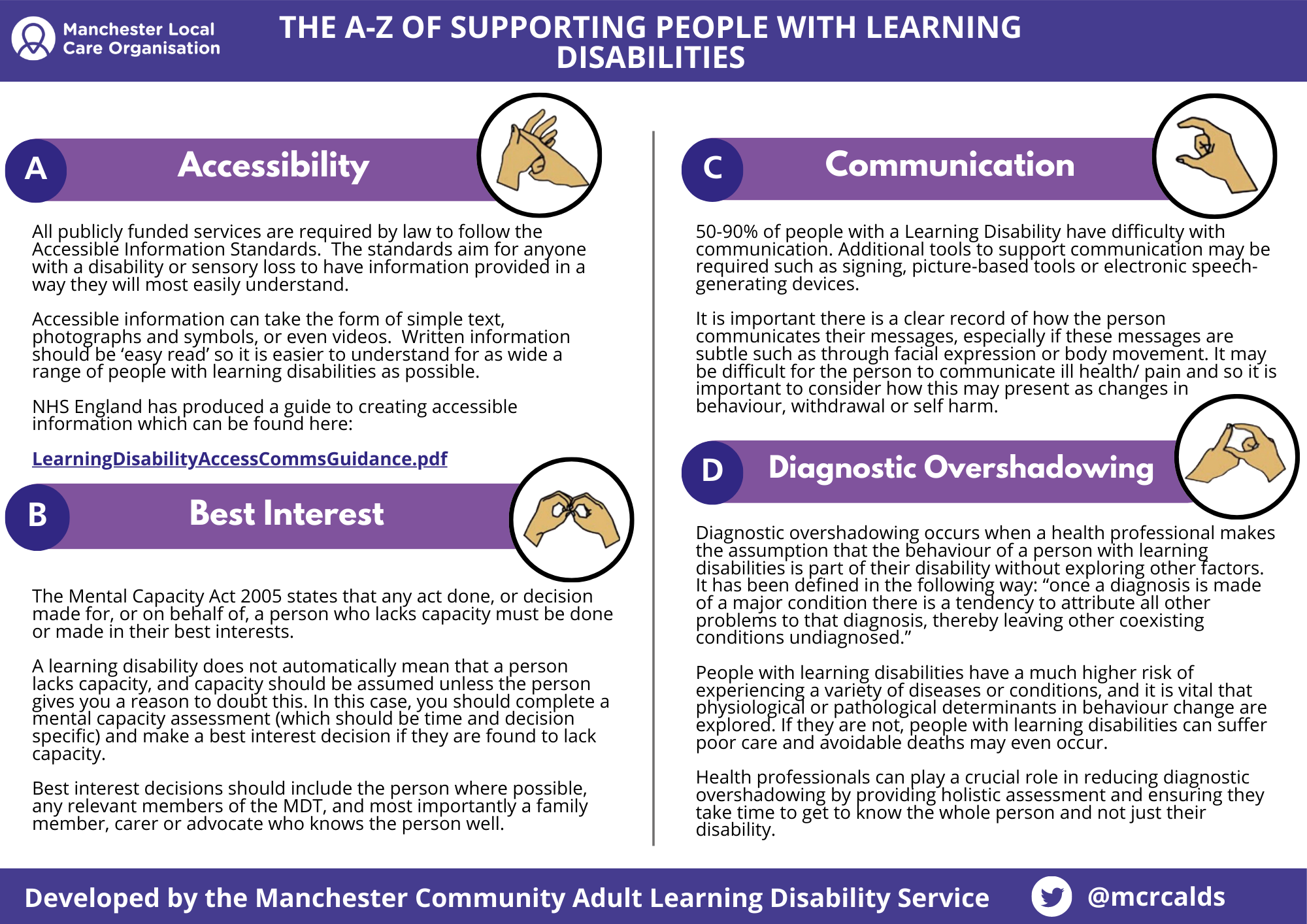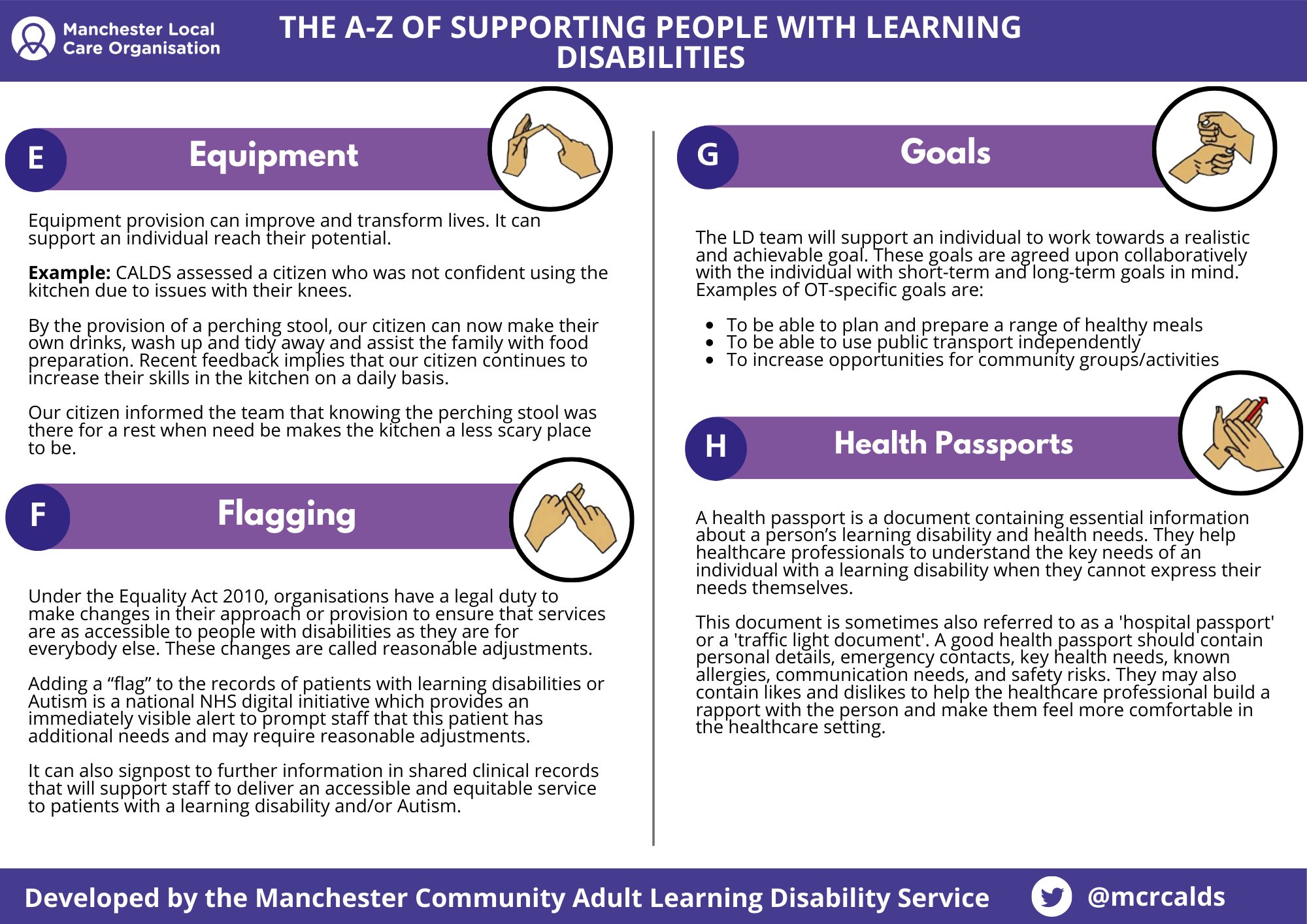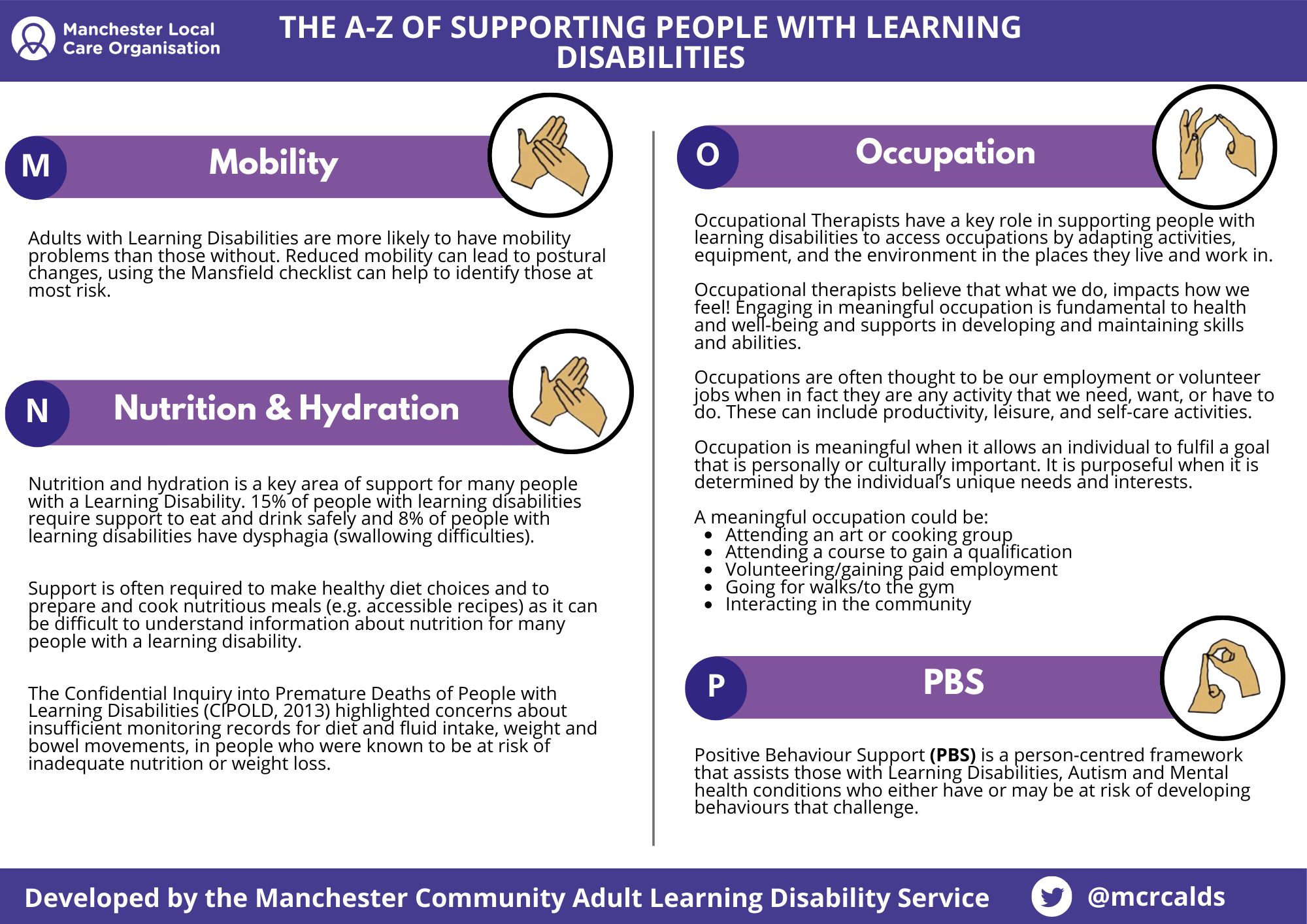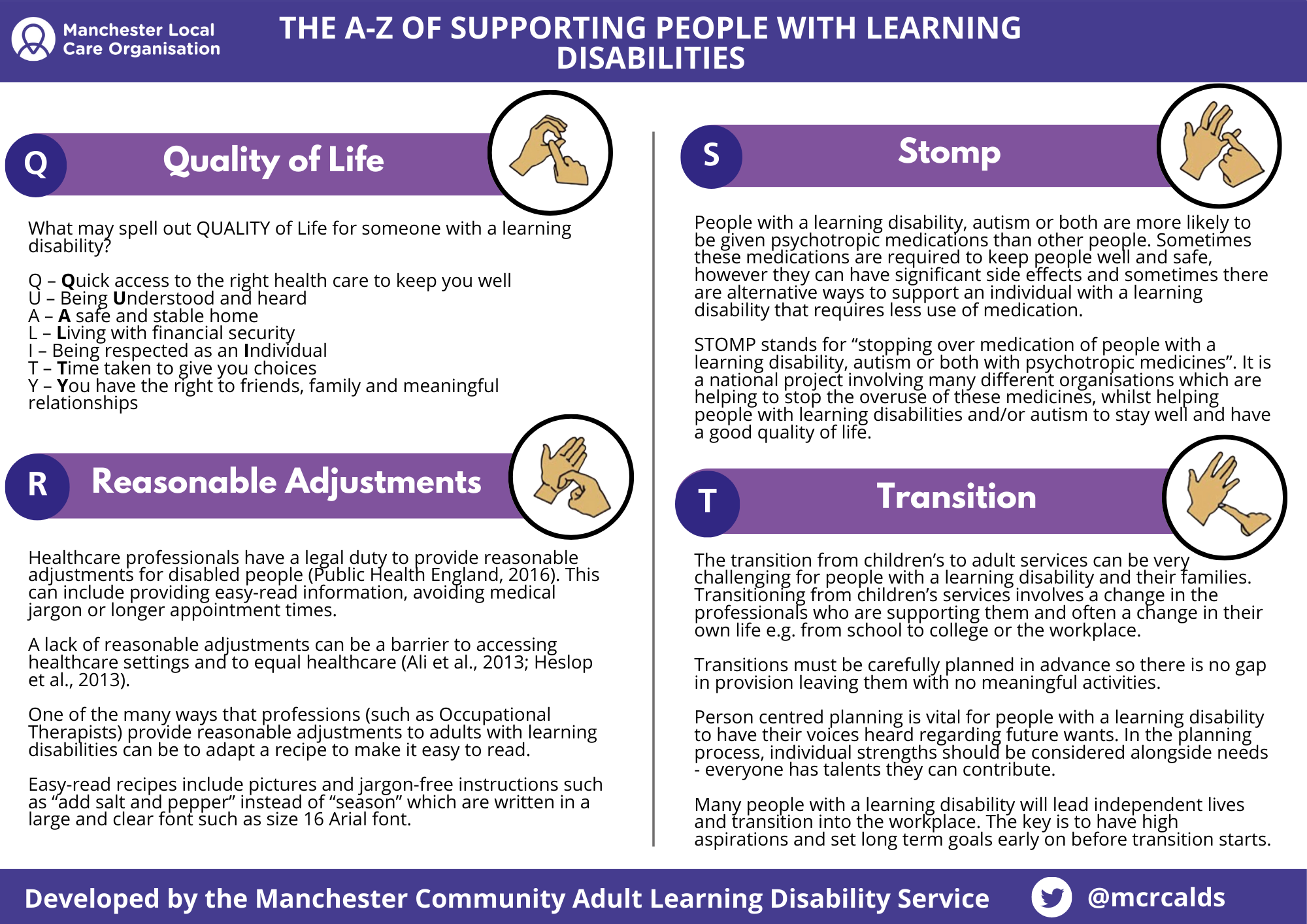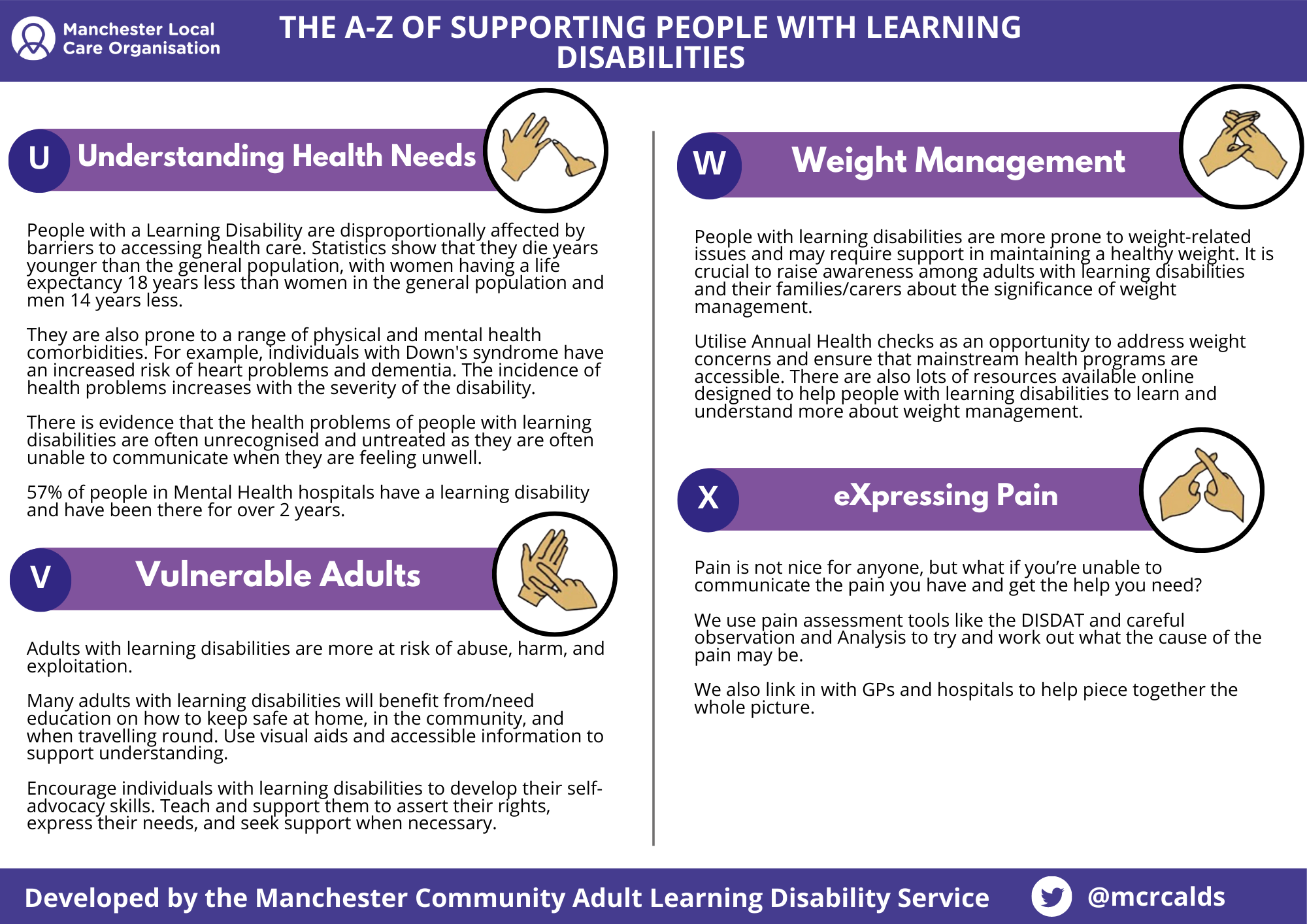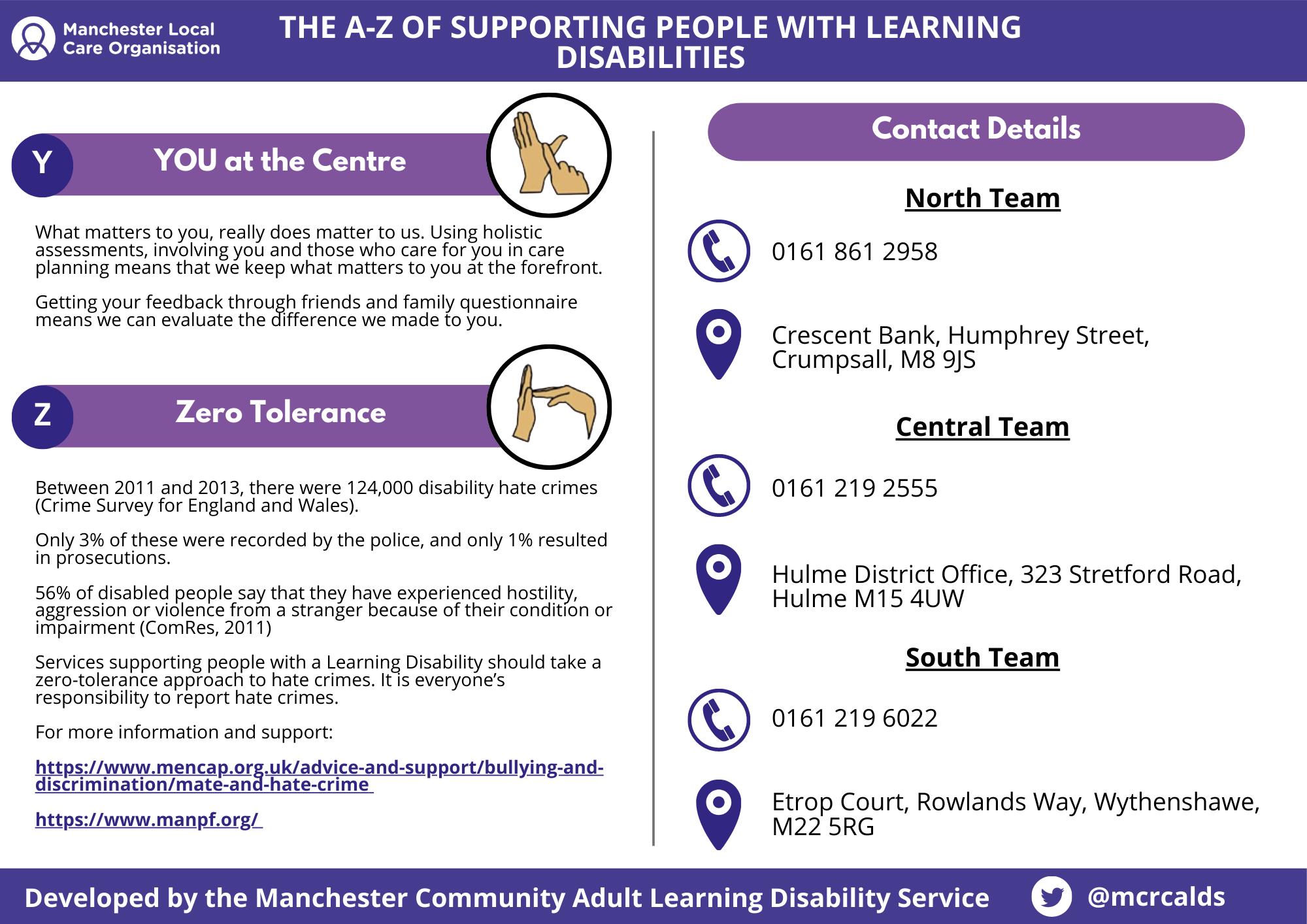The A-Z of Supporting People With a Learning Disability
Using each letter of the alphabet, professionals from across our Community Adult Learning Disability Service (CALDS) have put together this informative guide on how to support people with a learning disability.
To view the PDF document with full-sized pages, please click here.
A – Accessibility
All publicly funded services are required by law to follow the Accessible Information Standards. The standards aim for anyone with a disability or sensory loss to have information provided in a way they will most easily understand.
Accessible information can take the form of simple text, photographs and symbols, or even videos. Written information should be ‘easy read’ so it is easier to understand for as wide a range of people with learning disabilities as possible.
NHS England has produced a guide to creating accessible information which can be found here:
LearningDisabilityAccessCommsGuidance.pdf
B – Best Interest
The Mental Capacity Act 2005 states that any act done, or decision made for, or on behalf of, a person who lacks capacity must be done or made in their best interests.
A learning disability does not automatically mean that a person lacks capacity, and capacity should be assumed unless the person gives you a reason to doubt this. In this case, you should complete a mental capacity assessment (which should be time and decision specific) and make a best interest decision if they are found to lack capacity.
Best interest decisions should include the person where possible, any relevant members of the MDT, and most importantly a family member, carer or advocate who knows the person well.
C – Communication
50-90% of people with a Learning Disability have difficulty with communication. Additional tools to support communication may be required such as signing, picture-based tools or electronic speech-generating devices.
It is important there is a clear record of how the person communicates their messages, especially if these messages are subtle such as through facial expression or body movement. It may be difficult for the person to communicate ill health/ pain and so it is important to consider how this may present as changes in behaviour, withdrawal or self-harm.
D – Diagnostic Overshadowing
Diagnostic overshadowing occurs when a health professional makes the assumption that the behaviour of a person with learning disabilities is part of their disability without exploring other factors. It has been defined in the following way: “once a diagnosis is made of a major condition there is a tendency to attribute all other problems to that diagnosis, thereby leaving other coexisting conditions undiagnosed.”
People with learning disabilities have a much higher risk of experiencing a variety of diseases or conditions, and it is vital that physiological or pathological determinants in behaviour change are explored. If they are not, people with learning disabilities can suffer poor care and avoidable deaths may even occur.
Health professionals can play a crucial role in reducing diagnostic overshadowing by providing holistic assessment and ensuring they take time to get to know the whole person and not just their disability.
E – Equipment
Equipment provision can improve and transform lives. It can support an individual reach their potential.
Example: CALDS assessed a citizen who was not confident using the kitchen due to issues with their knees.
By the provision of a perching stool, our citizen can now make their own drinks, wash up and tidy away and assist the family with food preparation. Recent feedback implies that our citizen continues to increase their skills in the kitchen on a daily basis.
Our citizen informed the team that knowing the perching stool was there for a rest when need be makes the kitchen a less scary place to be.
F – Flagging
Under the Equality Act 2010, organisations have a legal duty to make changes in their approach or provision to ensure that services are as accessible to people with disabilities as they are for everybody else. These changes are called reasonable adjustments.
Adding a “flag” to the records of patients with learning disabilities or Autism is a national NHS digital initiative which provides an immediately visible alert to prompt staff that this patient has additional needs and may require reasonable adjustments.
It can also signpost to further information in shared clinical records that will support staff to deliver an accessible and equitable service to patients with a learning disability and/or Autism.
G – Goals
The LD team will support an individual to work towards a realistic and achievable goal. These goals are agreed upon collaboratively with the individual with short-term and long-term goals in mind. Examples of OT-specific goals are:
- To be able to plan and prepare a range of healthy meals
- To be able to use public transport independently
- To increase opportunities for community groups/activities
H – Health Passports
A health passport is a document containing essential information about a person’s learning disability and health needs. They help healthcare professionals to understand the key needs of an individual with a learning disability when they cannot express their needs themselves.
This document is sometimes also referred to as a ‘hospital passport’ or a ‘traffic light document’. A good health passport should contain personal details, emergency contacts, key health needs, known allergies, communication needs, and safety risks. They may also contain likes and dislikes to help the healthcare professional build a rapport with the person and make them feel more comfortable in the healthcare setting.
I – Inclusivity
We believe in breaking down barriers to ensure inclusivity. Enjoying sports for example, either individually or as a team should be promoted when looking at someone’s health and social needs. Some may hate exercise but everyone loves activity!
J – Joint Working
The community learning disability team works alongside social care, hospitals, GPs, other health services, community organisations, day services, colleges, charities and other support services….the list is endless!
Putting the person first and working together alongside people with a learning disability and their carers helps the person to live their life to the fullest.
K – Knowledge
Knowledge is key – a person with a learning disability might be supported in any healthcare setting by any professional.
It is mandatory that all health and social care staff complete some level of learning disability and autism awareness training to enable them to identify patients with additional needs and how to support them to access appropriate health and social care services.
Sadly, there are many examples of preventable deaths for people with learning disabilities where health care has gone wrong due to a lack of awareness and reasonable adjustments.
You can read Oliver McGowan’s story here: Oliver McGowan | Oliver’s Campaign |
Within MFT & the MLCO there are specialist learning disability practitioners who may be able to support you when you identify a patient with learning disabilities – make sure you know how to contact them (see intranet).
L – Least Restrictive Practice
Restrictive practice refers to any practice that restricts the rights or freedom of movement of any individual. Sometimes, a person with a learning disability may present in a way that puts themselves or others at harm. In these instances, restrictions may need to be used as part of a best interests decision to keep them safe.
This could include using physical restraint, sedative medications, or preventing them from leaving a particular place. In these instances, the least restrictive practice must be used – this means that the restriction used must be proportionate to the risk and that the least restrictive option to manage the risk has been used.
In some cases, you may need Court of Protection authorisation to restrict an individual’s liberty, and you may need to make a DOLs application.
M – Mobility
Adults with Learning Disabilities are more likely to have mobility problems than those without. Reduced mobility can lead to postural changes, using the Mansfield checklist can help to identify those at most risk.
N – Nutrition & Hydration
Nutrition and hydration is a key area of support for many people with a Learning Disability. 15% of people with learning disabilities require support to eat and drink safely and 8% of people with learning disabilities have dysphagia (swallowing difficulties).
Support is often required to make healthy diet choices and to prepare and cook nutritious meals (e.g. accessible recipes) as it can be difficult to understand information about nutrition for many people with a learning disability.
The Confidential Inquiry into Premature Deaths of People with Learning Disabilities (CIPOLD, 2013) highlighted concerns about insufficient monitoring records for diet and fluid intake, weight and bowel movements, in people who were known to be at risk of inadequate nutrition or weight loss.
O – Occupation
Occupational Therapists have a key role in supporting people with learning disabilities to access occupations by adapting activities, equipment, and the environment in the places they live and work in.
Occupational therapists believe that what we do, impacts how we feel! Engaging in meaningful occupation is fundamental to health and well-being and supports in developing and maintaining skills and abilities.
Occupations are often thought to be our employment or volunteer jobs when in fact they are any activity that we need, want, or have to do. These can include productivity, leisure, and self-care activities.
Occupation is meaningful when it allows an individual to fulfil a goal that is personally or culturally important. It is purposeful when it is determined by the individual’s unique needs and interests.
A meaningful occupation could be:
- Attending an art or cooking group
- Attending a course to gain a qualification
- Volunteering/gaining paid employment
- Going for walks/to the gym
- Interacting in the community
P – PBS
Positive Behaviour Support (PBS) is a person-centred framework that assists those with Learning Disabilities, Autism and Mental health conditions who either have or may be at risk of developing behaviours that challenge them.
Q – Quality of Life
What may spell out QUALITY of Life for someone with a learning disability?
Q – Quick access to the right health care to keep you well
U – Being Understood and heard
A – A safe and stable home
L – Living with financial security
I – Being respected as an Individual
T – Time taken to give you choices
Y – You have the right to friends, family and meaningful relationships
R – Reasonable Adjustments
Healthcare professionals have a legal duty to provide reasonable adjustments for disabled people (Public Health England, 2016). This can include providing easy-read information, avoiding medical jargon or longer appointment times.
A lack of reasonable adjustments can be a barrier to accessing healthcare settings and to equal healthcare (Ali et al., 2013; Heslop et al., 2013).
One of the many ways that professionals (such as Occupational Therapists) provide reasonable adjustments to adults with learning disabilities can be to adapt a recipe to make it easy to read.
Easy-read recipes include pictures and jargon-free instructions such as “add salt and pepper” instead of “season” which are written in a large and clear font such as size 16 Arial font.
S – STOMP
People with a learning disability, autism or both are more likely to be given psychotropic medications than other people. Sometimes these medications are required to keep people well and safe, however they can have significant side effects and sometimes there are alternative ways to support an individual with a learning disability that requires less use of medication.
STOMP stands for “stopping over medication of people with a learning disability, autism or both with psychotropic medicines”. It is a national project involving many different organisations which are helping to stop the overuse of these medicines, whilst helping people with learning disabilities and/or autism to stay well and have a good quality of life.
T – Transition
The transition from children’s to adult services can be very challenging for people with a learning disability and their families. Transitioning from children’s services involves a change in the professionals who are supporting them and often a change in their own life e.g. from school to college or the workplace.
Transitions must be carefully planned in advance so there is no gap in provision leaving them with no meaningful activities.
Person-centred planning is vital for people with a learning disability to have their voices heard regarding future wants. In the planning process, individual strengths should be considered alongside needs – everyone has talents they can contribute.
Many people with a learning disability will lead independent lives and transition into the workplace. The key is to have high aspirations and set long term goals early on before transition starts.
U – Understanding Health Needs
People with a Learning Disability are disproportionally affected by barriers to accessing health care. Statistics show that they die years younger than the general population, with women having a life expectancy 18 years less than women in the general population and men 14 years less.
They are also prone to a range of physical and mental health comorbidities. For example, individuals with Down’s syndrome have an increased risk of heart problems and dementia. The incidence of health problems increases with the severity of the disability.
There is evidence that the health problems of people with learning disabilities are often unrecognised and untreated as they are often unable to communicate when they are feeling unwell.
57% of people in Mental Health hospitals have a learning disability and have been there for over 2 years.
V – Vulnerable Adults
Adults with learning disabilities are more at risk of abuse, harm, and exploitation.
Many adults with learning disabilities will benefit from/need education on how to keep safe at home, in the community, and when travelling round. Use visual aids and accessible information to support understanding.
Encourage individuals with learning disabilities to develop their self-advocacy skills. Teach and support them to assert their rights, express their needs, and seek support when necessary.
W – Weight Management
People with learning disabilities are more prone to weight-related issues and may require support in maintaining a healthy weight. It is crucial to raise awareness among adults with learning disabilities and their families/carers about the significance of weight management.
Utilise Annual Health checks as an opportunity to address weight concerns and ensure that mainstream health programs are accessible. There are also lots of resources available online designed to help people with learning disabilities to learn and understand more about weight management.
X – eXpressing Pain
Pain is not nice for anyone, but what if you’re unable to communicate the pain you have and get the help you need?
We use pain assessment tools like the DISDAT and careful observation and Analysis to try and work out what the cause of the pain may be.
We also link in with GPs and hospitals to help piece together the whole picture.
Y – YOU at the Centre
What matters to you, really does matter to us. Using holistic assessments, involving you and those who care for you in care planning means that we keep what matters to you at the forefront.
Getting your feedback through friends and family questionnaire means we can evaluate the difference we made to you.
Z – Zero Tolerance
Between 2011 and 2013, there were 124,000 disability hate crimes (Crime Survey for England and Wales).
Only 3% of these were recorded by the police, and only 1% resulted in prosecutions.
56% of disabled people say that they have experienced hostility, aggression or violence from a stranger because of their condition or impairment (ComRes, 2011)
Services supporting people with a Learning Disability should take a zero-tolerance approach to hate crimes. It is everyone’s responsibility to report hate crimes.
For more information and support:
https://www.mencap.org.uk/advice-and-support/bullying-and-discrimination/mate-and-hate-crime
Please click here to view a text-only version of the A-Z [Web page]

